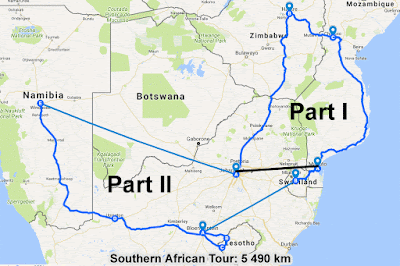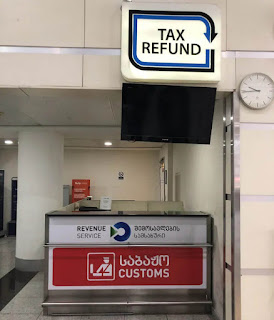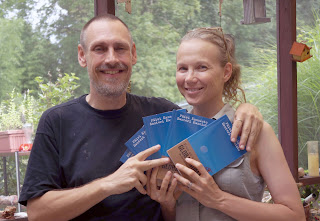From South Africa to Zimbabwe and Mozambique by Bus
The bus trip from South Africa to Zimbabwe and through Mozambique is not the most pleasant road trip but still doable.
We continued exploring the Southern part of Africa by bus. The whole tour was 5 490 km across South Africa, Zimbabwe, Mozambique, Swaziland, Lesotho, and Namibia. We have cut the journey into two parts to make reading a bit more tolerable:
- Part I: 2 622 km Johannesburg-Harare (Zimbabwe)-Chimoio (Mozambique)-Maputo (Mozambique)
- Part II: 2 868 km Maputo-Manzini (Swaziland)-Bloemfountain-Maseru (Lesotho)-Windhoek (Namibia)
The trip was typically African: bad roads with potholes, slow and aggressive driving, delays at borders because of visas and custom checks (i.e. corruption), and bus breakups.
From South Africa to Zimbabwe
The toll roads in South Africa are good and the drive to the Zimbabwe border went smoothly (Intercape, 500 ZAR per person). Unfortunately, South African immigration in Beitbridge is inefficiently organised and crowded. There were only two officials serving the passengers of more than six big buses. It seems that all bus companies arrive at the border at the same time so queues cannot be avoided. There is a lot of traffic because Zimbabwe has suffered from a depression for seven years, and those who are able to move abroad prefer to work in South Africa. In our bus, one of the passengers was deported because she had overstayed her South-African visa. Customs inspection was also slow as all bags were taken out from the trunk, although they were not inspected by the officials.
The South-African border, however, was nothing compared to the Zimbabwe border. We got stuck in a queue of over dozen buses. The police had arrested customs officials for taking bribes, and the rest of the officials were protesting by working super slowly. The process took five hours and would have taken even longer if Intercape had not been such a profitable "customer" for the officials. Four other buses, that had arrived before us, had been waiting for their turn for more than 24 hours. Other passengers in the bus were very friendly and helped us at the border as it wasn't always clear where to go and what to do. In Zimbabwe customs, for example, passengers were expected to fetch blue papers from one of the surrounding buildings and the papers had to be filled in a specific way to avoid delays and problems.
Since we were already five hours behind the schedule, the drivers made a generous amount of stops on the way. We did not mind as the bus toilet got stuck right after the departure, and the bus had not stopped even once in South Africa.
From Zimbabwe to Mozambique
If you want to make your visit to Zimbabwe extraordinary and exciting, tell the immigration officials that you are an author — or even better, a journalist. Päivi did this and got a special treatment. The official drew a big circle around the word 'author' and wrote Päivi a "notice of a visitor". We had to decide where we were staying during our visit and from where we would exit the country. We hadn't any plans and said vaguely that perhaps we will return back to South Africa or continue straight to Mozambique. The official wasn't happy about this and ordered us to choose. We ended up mumbling Mozambique. Hence, Päivi was to report at the Mozambique border station in Forbes when exiting the country.
There were not too many bus companies going from Harare to Mozambique. After relaxing a week in Mount Pleasant in Harare, we hopped into the notorious Trip Trans bus (30 Zimbabwe bonds per person). The company is known for speeding and killing passengers and pedestrians. We expected the worst, particularly because the roads in Zimbabwe are not in mint condition, but we were pleasantly surprised; the road to Mozambique was better than the road to South Africa. The bus was not full but the seating was uncomfortable: 3+2 with no leg room. Moreover, bus was damp because there was no air-conditioning. As said, though, the trip was much better than we feared and there were no queues at the Machipanda border station. The only delay was because of the visa-on-arrival. The immigration officials were slow and meticulous. The bus was already hurrying away so we had to run after the bus in the middle of the process and beg the driver to wait for us. Moreover, the price of the visa was outrageously high compared to local price levels: 50 USD/month (on February 16, 2018). We had earlier read on the Internet that the price should have been US $30/month just like in Zimbabwe, but when we told this to the senior immigration official, he got enraged, blamed us that we were lying and insisted on showing him immediately "the proof". We learned later that the trick is to pay the visa in local currency. It should cost 2000 MZN (Mozambican meticais), which is about US $30.
Ride across Mozambique
After relaxing for a while in Chimoio in central Mozambique, we took a bus to Maputo. We chose LTM, which is said to be the safest and most reliable (1800 MZN per person). The bus was quite OK. The seating is 2+2 and the bus had air-conditioning. There was a downside, however: the air-con wasn't adjustable. It was either on or off. When the outside temperature dropped to 22, there was 15 degrees Celsius inside! We had only t-shirts on because we thought that an African AC wouldn't probably work well if at all.
The road from Chimoio to Maputo is very bad until Vilanculo. The potholes were sometimes 2-10 meters wide! The first 100 kilometres took five hours. After Vilanculo, the road was pretty OK for and we did arrive during the same day just as the bus company had promised us. During the whole trip, there was only one driver. His work shift was 15 hours long without a single break. The speed varied between 20 km/h and 140 km/h depending on the road condition, weather, and the time of day. As the driver was not a young guy and still alive, that made him a hell of a good driver, probably one of the best in Africa.
Life in Africa
There are frequent power cuts and water service disruptions both in Zimbabwe and in Mozambique. Interruptions can occur several times a day even in the poshest neighbourhoods. Unless you're in a place that has a backup generator, you will be at the mercy of water and electricity companies. During the dry season, it will be hot and there are no fans or AC available except in luxury hotels. On the other hand, many of the amenities become useless if there is no electricity available.
During the rainy season, roads get very muddy so it's a good idea to pack a pair of old jogging shoes that you don't need to care about. Other useful stuff to take with you include shampoo made for Western hair, particularly if you are going to stay in little towns or villages as they might only have some local egg and apple shampoos for coarse African hair.
Enjoy your trip! You will see a lot of antique things and phenomena. For example in Maputo, we saw a bunch of tailors that were using old treadle Singer sewing machines on the street!









Comments